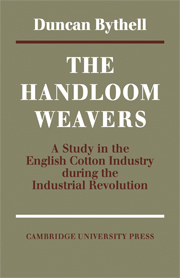Book contents
- Frontmatter
- Contents
- Preface
- Introduction
- Map of the weaving towns and villages of north-east Lancashire in 1821
- 1 Problems and sources
- 2 The organization of the industry
- 3 The labour force
- 4 The coming of the powerloom
- 5 Wages: (I) The piece-rate
- 6 Wages: (II) Earnings and the standard of living
- 7 Public opinion and the handloom weavers
- 8 Organized industrial action among the cotton handloom weavers
- 9 The weavers and radical politics
- 10 The problem of poverty
- 11 Displacement and disappearance
- Appendix 1 Some piece-rate series
- Appendix 2 The piece-rate and the price of food
- Appendix 3 G. H. Wood's estimates of average weekly earnings
- Bibliography
- Index
5 - Wages: (I) The piece-rate
Published online by Cambridge University Press: 07 October 2011
- Frontmatter
- Contents
- Preface
- Introduction
- Map of the weaving towns and villages of north-east Lancashire in 1821
- 1 Problems and sources
- 2 The organization of the industry
- 3 The labour force
- 4 The coming of the powerloom
- 5 Wages: (I) The piece-rate
- 6 Wages: (II) Earnings and the standard of living
- 7 Public opinion and the handloom weavers
- 8 Organized industrial action among the cotton handloom weavers
- 9 The weavers and radical politics
- 10 The problem of poverty
- 11 Displacement and disappearance
- Appendix 1 Some piece-rate series
- Appendix 2 The piece-rate and the price of food
- Appendix 3 G. H. Wood's estimates of average weekly earnings
- Bibliography
- Index
Summary
Historians still debate whether, in the account-book of the English industrial revolution, the debit or the credit pages should contain the greater number of entries. But on one point they are unanimous: the deterioration in the material condition of the handloom weavers and similar groups of domestic workers in large and relatively unskilled trades was one of the least happy consequences of the economic developments of the period 1780–1850. The traditional picture of a decline in living standards is supported by a mass of evidence. The parliamentary inquiries of the early 1830s abound in comparisons between the weavers' prosperity in the last years of the eighteenth century and their recent miseries. A Bolton manufacturer in 1834 reflected thus on the status of a weaver in this vanished ‘golden age’: ‘it was the trade of a gentleman; they brought home their work in top boots and ruffled shirts; they had a cane and took a coach in some instances, and appeared as well as officers of the first degree when they appeared alone.’ An old Glasgow weaver, looking back from the same year, remembered that in his youth ‘it was quite common for a handloom weaver to lay in as much meal, potatoes, cheese and butter in harvest as would serve till spring, and coals were laid in in larger quantities, and very commonly handloom weavers salted meat at Martinmas for winter’.
- Type
- Chapter
- Information
- The Handloom Weavers , pp. 94 - 113Publisher: Cambridge University PressPrint publication year: 1969



